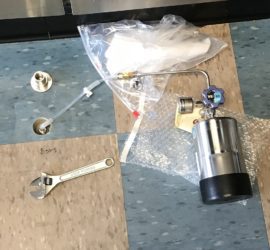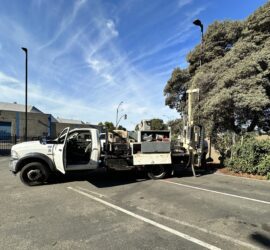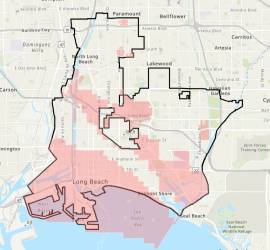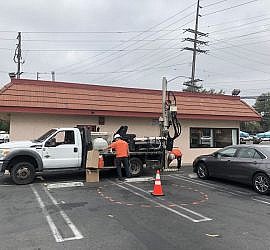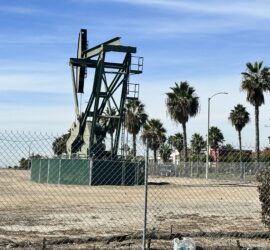Methane Investigation (or Methane Soil Investigation)
The purpose of a methane investigation, or a methane soil investigation, is to study the presence and origin of subsurface methane and hydrogen sulfide gases. For instance, some sources of methane gas can be from petroleum fields, whereas others can be from landfill sites. A methane investigation differs from a methane test because it comprises the laboratory analysis of samples for the study of gas types. Updated April 9, 2024.
Methane Investigation vs Methane Test
A methane test aims to sample soil gas and determine the proper methane mitigation design parameters to implement on future developments. Similarly, a methane soil investigation also samples soil gas… However, the methods of analysis, as well as the results, differ significantly. To illustrate, a methane test produces quantitative data results via a field flame ionization detector (FID). Whereas the methane investigation process comprises the containing of soil gas within 1-liter SUMMA canisters, for qualitative data results via laboratory analysis.
About Methane
Methane has no color, nor a detectible odor. The gas can migrate underground through soil layers and structure foundations. As a result, the soil gas can accumulate inside buildings. The accumulations of this subsurface gas typically derive from oil and gas fields, extraction wells, coal mines, and landfills. Modern regulations about the hazards of methane soil gas come from various explosions in Los Angeles. Since then, various building departments and public works agencies have recommended methane barriers and other mitigation measures within specific methane hazard zones.
Natural Gas
Natural gas is a hydrocarbon gas that comes from historical geological and biological processes. It has high combustion properties and is the product of the decomposition of organic matter. The substance exists in high-pressure pockets underground.
Petro-Genic Gas aka Petroleum Base Gases
Petroleum base gasses, or “petro-genic gasses” are the types of natural gas deriving from the thermal decomposition process of organic matter. Petro-genic gases are typically present within petroleum fields.
Biological Gas aka Bio-Genic Gas
Biologically generated gas is “bio-genic gas.” This is the natural gas that comes from the microbial decomposition process. Bio-genic gas is common in landfill areas, as well as swamp fields and wetland areas.
Places to Perform a Methane Soil Investigation
During the late 1800s and early 1900s, oil and gas drilling was a large part of the industrial activities of central and southern California. In fact, the Monterey Geologic Formation was a predominant source of crude oil. And outcrops of it exist throughout the coast of California. The northernmost areas of California have an abundance of natural gas.
Los Angeles Methane Fields
The City of Los Angeles prepares a map of high-risk Methane Zones and Methane Buffer Zones. Similarly, other agencies enforce methane mitigation guidelines with parallel zoning methods. In general, sites that are within these hazard zones require methane soil gas surveys before undergoing construction or demolition. Citywide methane mitigation requirements are available for review in Ordinance No. 175790 and Ordinance No. 180619. Sometimes, a methane investigation in furtherance of a soil gas survey can modify the mitigation requirements for a site.
Los Angeles County
Other cities in Los Angeles County fall under the jurisdiction of the Los Angeles County Methane Mitigation Unit. Per this oversight program, sites generally require methane soil gas surveys on construction sites within 1,000 feet of a landfill or 300 feet of an oil & gas well. Alternatively, the results of a methane soil investigation can deter the mitigation requirements by the County.
Huntington Beach
Huntington Beach and other cities within Orange County also publication subsurface methane hazard zone maps. And each agency has similar mitigation requirements as Los Angeles.
Building Departments & Methane Assessment
Geo Forward offers methane assessment services to meet the requirements of all building jurisdictions in California (including Los Angeles City, Los Angeles County, Huntington Beach, Ventura County, and more). The methane soil investigation and testing processes include the determination of methane gas sources, as well as the assignment of appropriate mitigation levels for health and safety purposes.
Methane Mitigation Plans
Local building departments may also require methane mitigation plans to reduce the dangers to occupants. For example, asphyxiation due to oxygen displacement. Or explosion at the point of ignition.
Standard Depths & Turnaround Times
A standard methane investigation reflects the shallow soil gas underlying a property. While methane test results are fast from the field, methane soil investigation results generally take five business days for laboratory results to turn around.
Basic Assessments for Real Estate Due Diligence
When there isn’t a requirement for a comprehensive investigation, a basic assessment can be an affordable option to assist buyers and sellers for due diligence reasons. Such reports help buyers and investors understand subsurface conditions for risk liability and planning reasons, before development. In such cases, Geo Forward also offers basic methane investigations. If the findings of a basic study warrant a follow-up comprehensive assessment, the initial phase data can be applied to eliminate the extent of the hazard zone.

